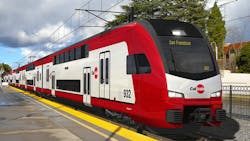Caltrain adds new Electric Train cars as part of Rail Electrification project
Caltrain, the commuter rail line in service from San Francisco to San Joes, has unveiled its new electric train cars by Stadler US.
The additions are part of its Caltrain Electrification Project, which will electrify the corridor from the San Francisco Station at 4th and King Streets to approximately the Tamien Station in San Jose. This project will require another $410 million over the initial estimates.
Each new trainset will have seven cars instead of the current five or six. The trains will accelerate and decelerate faster than diesel trains, allowing Caltrain to expand service level from the current 104 trains every weekday.
“The transportation sector makes up 50 percent of California’s greenhouse gas emissions, and electrifying our public transit systems is one of the most effective ways to cut down on those emissions,” said U.S. Sen. Diane Feinstein. “I join Caltrain in celebrating the arrival of its first electric train. I have long supported funding for the Caltrain Peninsula Corridor Electrification project and will continue to work to secure funds for this important effort.”
More e-Mobility coverage from EnergyTech
Amtrak aims to achieve Net Zero GHG Emissions by 2045
Ballard Fuel Cells to be used in Siemens Mobility Mireo Plus H2 Trains on Berlin Route
New webinar on how U.S. projects can connect with new Federal Incentives: Now is the Moment
The trains will also have more amenities, like digital onboard displays, power outlets at each forward-facing seat, a new seat color palette selected by the public, energy-efficient lighting, coat hooks, security cameras, and more storage under seats.
They will go into service in 2024. The trains were already tested under numerous conditions as per the Federal Railroad Administration guidelines. They were tested for braking, propulsion, noise and vibration, ride quality, door operation, Positive Train Control and Electromagnetic Interference over eight months. Testing will continue.
CalTrain leaders say the project will improve customer experience by increasing the number of trains, modernizing service and adding safety elements. It will also help meet climate goals by reducing greenhouse gas emissions, relieving traffic congestion and improving air quality.
The CalTrain modernization project, years in the planning, will spend more than $2.4 billion to update and electrify the line.
About the Author
EnergyTech Staff
Rod Walton is head of content for EnergyTech.com. He has spent 17 years covering the energy industry as a newspaper and trade journalist.
Walton formerly was energy writer and business editor at the Tulsa World. Later, he spent six years covering the electricity power sector for Pennwell and Clarion Events. He joined Endeavor and EnergyTech in November 2021.
He can be reached at [email protected].
EnergyTech is focused on the mission critical and large-scale energy users and their sustainability and resiliency goals. These include the commercial and industrial sectors, as well as the military, universities, data centers and microgrids.
Many large-scale energy users such as Fortune 500 companies, and mission-critical users such as military bases, universities, healthcare facilities, public safety and data centers, shifting their energy priorities to reach net-zero carbon goals within the coming decades. These include plans for renewable energy power purchase agreements, but also on-site resiliency projects such as microgrids, combined heat and power, rooftop solar, energy storage, digitalization and building efficiency upgrades.
